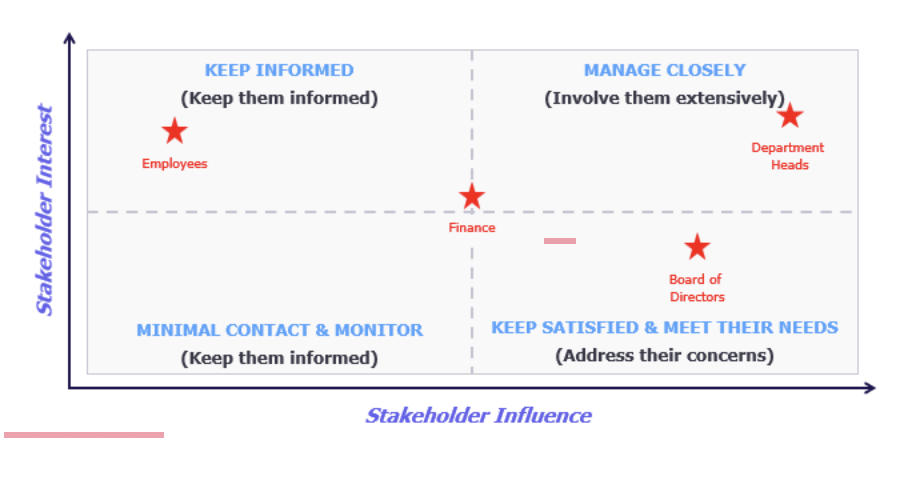
Executive Summary
AI has the potential to radically improve business performance, yet many initiatives stall due to lack of AI stakeholder engagement alignment. This article outlines nepf’s proven seven-element framework to help leaders secure executive and organizational support for AI transformations. Backed by real-world case studies and pragmatic strategies, it’s a guide to turning great ideas into adopted, sustained change.
AI Won’t Transform Your Business, People Will
An MIT report reveals that 87% of AI projects underdeliver, with misaligned stakeholders as a key factor. Despite the buzz surrounding artificial intelligence, most AI initiatives don’t fail because of flawed technology. They fail because of a lack of alignment, communication, and buy-in from the people expected to adopt and implement it.
Effective AI stakeholder engagement management is critical for building a compelling case for AI and essential for project success
- Identifies potential barriers and resistance for proactive mitigation strategies.
- Creates a sense of ownership and involvement.
- Leads to more informed decision-making and the development of tailored solutions.
- Promotes collaboration and considers diverse perspectives.
The Leadership Gap: Why AI Initiatives Falter
Organizations eager to unlock AI’s potential often overlook the foundational element of change: people. When stakeholder concerns aren’t addressed early, the most sophisticated AI platform can become an unused relic.
Consider a Senior Vice President of Customer Service at a major retail firm. She identifies an opportunity to deploy AI to enhance response times, improve customer satisfaction, and reduce operational costs. The technology is sound. But gaining stakeholder support proves daunting: employees fear job losses, department heads worry about budget constraints, and the board is sceptical of ROI projections.
The result? Slow adoption, organizational resistance, and wasted investment.
The nature of AI and its sensitivity to individuals’ perceptions of its impact on their careers means that strong leadership is more essential than ever. Leaders must possess a clear vision of how AI will benefit the organization and work to convey this vision effectively to their teams. This includes, for example, explaining the purpose of AI, addressing any concerns or fears, and inspiring confidence in the new technology.
nepf’s approach helps leaders avoid this outcome. Our seven-element stakeholder framework offers a people-first roadmap to build trust, drive alignment, and ensure sustained adoption of AI initiatives.
The 7 Key Elements for Stakeholder Buy-In to AI initiatives
1. Identify All Relevant Stakeholders
AI transformations touch a broad range of roles. From frontline workers to senior leadership, it’s essential to understand who will be affected—and who has influence over success.
In our example of customer service at a retail firm this includes:
- Employees – frontline customer service representatives who must use the new AI tools daily.
- Department Heads – leaders in customer service, IT, HR, and operations, responsible for managing the transition.
- Finance – responsible for evaluating the cost-benefit analysis and ROI.
- Board of Directors – ultimately accountable for the strategic value and governance of such initiatives.
- Union Representatives or Employee Advocacy Groups (if applicable) – potential voices of influence regarding labor-related concerns.
2. Map Influence, Impact, and Interest
Not all stakeholders have the same influence, impact, or investment in the outcome. In our example:
- Department Heads have high influence due to control over budgets and resources.
- Employees have high impact (as they will directly use AI) and high interest, but often lower formal influence.
- Finance holds the power of the purse, making them critical decision-makers.
- The Board of Directors holds ultimate governance power but may show lower day-to-day interest unless risk or value is at stake.
By mapping influence vs impact vs interest, leaders can determine where to focus their engagement efforts most effectively.
3. Understand What Drives Stakeholders
Each stakeholder group in our example has different motivators:
- Employees want job security, clear training pathways, and assurance that AI will support rather than replace them.
- Department Heads seek improved efficiency, smoother workflows, and alignment with performance KPIs.
- Finance needs reliable cost modelling, accurate forecasting, and measurable ROI.
- Board Members are focused on long-term strategic impact, reputational risk, and shareholder value.
Understanding these motivations allows you to align your messaging and benefits accordingly.
4. Segment Supporters and Sceptics
Use a stakeholder heat map to categorize individuals or groups into champions, neutrals, and detractors.
In our example:
- One department head was initially resistant due to perceived budget pressure but became a supporter after learning AI would support her goals and make staff more productive.
- Mid-level team leads were passive at first, unsure of how AI would affect their roles. After involving them in pilot programs, they became active champions who helped influence adoption from within.
Targeted engagement and communication can help engage each group with the right message and channel.
5. Address Stakeholder Priorities
As you have developed a clear picture of each stakeholder’s needs, you can now craft a value proposition that meets each stakeholder’s specific concerns. Tailor your case:
- Present employees with a vision of what the future of their work will look like, for example, how non-value-added tasks will be automated, and their time can be spent on higher value tasks.
- Show Finance a phased investment model showing short-term efficiency gains and long-term scalability.
- Demonstrate to the Board how AI will be a competitive advantage and a tool for mitigating reputational risk.
6. Define Success Together
Rather than imposing success metrics, co-create them with stakeholders. In this scenario:
- Customer service reps defined success as reduced average handling time and less manual data entry.
- Department heads prioritized increased Net Promoter Scores (NPS) and faster response rates.
- Finance wanted to see a 10-15% reduction in service costs within two quarters.
Change spreads faster through informal networks. Identify and involve key influencers, regardless of title. For instance:
- Senior shift supervisors became critical allies. Once convinced of AI’s benefits, they reassured staff and modelled usage behaviours.
- A respected long-tenured rep who was sceptical at first became a powerful advocate after seeing efficiency improvements in a pilot.
These informal leaders helped overcome fear and accelerate cultural adoption from within. Shared ownership in defining goals builds trust and commitment.
7. Map Stakeholder Connections Strategically
You can now map stakeholder groups by interest and influence to determine the ideal engagement strategy.
In our example, this looks as follows:
From Strategy to Execution: 5 Best Practices
- Craft a Stakeholder-Specific Narrative
Build a tailored story for each group, explaining how the AI initiative addresses their specific goals. - Quantify Benefits and Highlight Quick Wins
Show how AI drives measurable value in the short term, not just in future-state models. - Elevate Influential Stakeholders
Create a network of change champions to drive momentum. - Communicate Relentlessly
Use multiple channels and repeat key messages. Confusion breeds resistance. - Monitor and Adapt Continuously
Stakeholder needs evolve. Adjust the plan based on real-time feedback and data.
Executive Action Plan
To gain internal buy-in and make your AI initiative stick, you need more than a solid tech strategy. You need a stakeholder strategy. Start with:
- Conducting a stakeholder impact analysis using nepf’s proprietary tools.
- Creating tailored communication plans for key stakeholder groups.
- Tracking engagement metrics to iterate your approach.
Want to ensure your AI transformation achieves its full potential?






